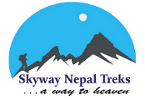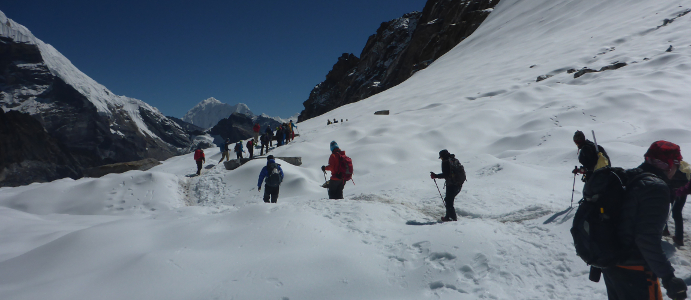
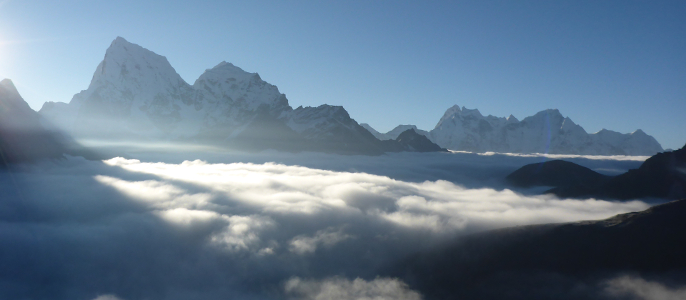
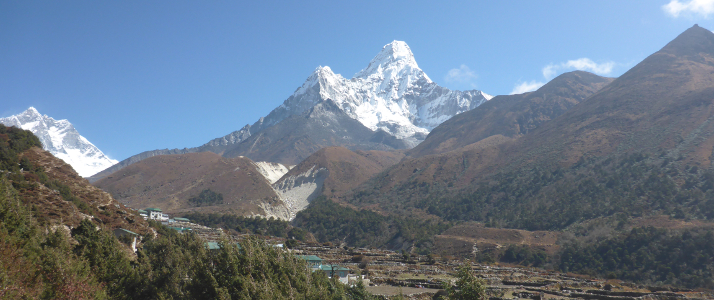
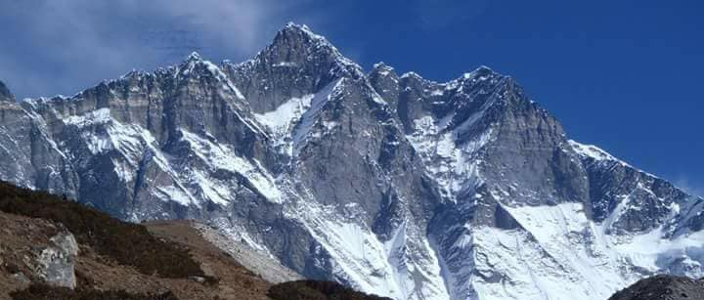
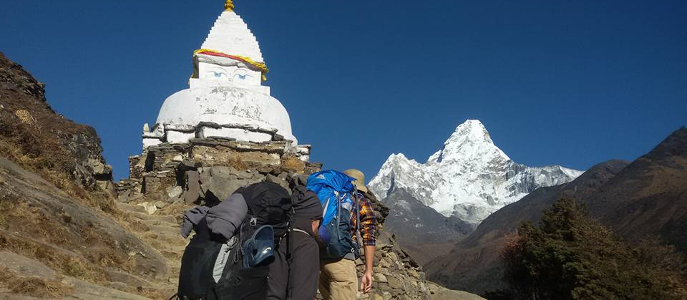
Everest Base Camp Three-Pass Trek – 21 Days
Highlight
Trek to an Everest Base Camp via three passes, climb Gokyo Ri and Kala Patthar for stunning views of sunrises and Mt Everest, and enjoy panoramic views of the Himalayas.
| Group size | 2 – 14 people |
| Trip duration | 21 days (including one contingency day in case of flight delay at Lukla) |
| Service level | Standard |
| Activities | Trekking and sightseeing |
| Maximum altitude | 5,535 m |
| Physical rating | Challenging |
| Arrival / Departure at | Kathmandu / Kathmandu |
| Transport | Domestic flights between Kathmandu and Lukla; private vehicle between destinations for the activities included in the itinerary |
| Meals included | Breakfast in Kathmandu; all meals during trekking; a welcome dinner and a farewell dinner |
| Accommodation | 3-star hotels or equivalent in Kathmandu; teahouses during trekking. All accommodation is on a double occupancy basis |
| Age requirements | 12+ (children under 18 must be accompanied by parent(s) |
Trip Description
For adventurous travelers, this trek is a thrilling challenge that is a must. In this trek, we will hike on the popular Everest trails, cross three passes – Renjo La Pass (5,345m), Chola La Pass (5,420m) and Kongma La Pass (5,535m), and visit the famous Everest Base Camp (5,365m).
The astonishing views of snowcapped mountains, the spectacular sunrise at Gokyo Ri, the great view of Mt Everest at Kala Patthar, the unique glaciers and glacial lakes, and much more, all make this adventure worthwhile.
During trekking, we will have lots of opportunities for close encounters of local culture. We will also visit the monastery village of Thame and the Sherpa village of Marlung. In addition, the Kathmandu Sightseeing Tour and Bhaktapur Tour are a feast of Nepal cultural heritage for your eyes.
Are you ready for this fantastic adventure to explore wonders of nature and conquer challenges of nature presented by the Himalayas? It can be a life-changing trip for you. For those who are looking for alternative treks, check out Everest Base Camp Trek via Gokyo Lakes 19 Days, Everest Base Camp Short Trek 16 Days, or Everest Base Camp Trek via Jiri 24 Days.
Itinerary Outline
- Day 1: Arrive in Kathmandu
- Day 2: Kathmandu sightseeing and trek preparation. Optional: Everest Mountain Flight
- Day 3: Fly to Lukla (2,826m, 30 min), then start trekking to Phakding (2,650m, 3 to 4 hours)
- Day 4: Phakding to Namche Bazar (3,444m, 5 to 6 hours)
- Day 5: Namche Bazaar - Acclimatization Day. Optional hike to Everest View Hotel (3,865m) to take the first peek of Mt Everest (2 to 3 hours)
- Day 6: Namche Bazaar to Thame (3,800m, 4 to 5 hours)
- Day 7: Thame to Marlung (4,200m, 5 to 6 hours)
- Day 8: Marlung via Renjo La Pass (5,345m) to Gokyo (4,750, 7 to 8 hours)
- Day 9: Gokyo – Acclimatization Day. Optional hike to Gokyo Ri (5,357m) in the early morning for a sunrise (3 hours)
- Day 10: Gokyo to Thangnak (4,700m, 3 to 4 hours)
- Day 11: Thangnak via Cho La Pass (5,420m) to Dzongla (4,840m, 8 to 9 hours)
- Day 12: Dzongla to Lobuche (4,920m, 4 to 5 hours)
- Day 13: Lobuche to Gorakshep (5,160m, 3 to 4 hours), then to Everest Base Camp (5,365m) and back to Gorakshep (3 to 4 hours)
- Day 14: Optional hike to Kala Patthar (5,545m) for a great view of Mt Everest and back to Gorakshep in the early morning (3 hours), then to Lobuche (4,920m, 2 to 3 hours)
- Day 15: Lobuche via Kongma La Pass (5,535m) to Chhukung (4,730m, 7 to 8 hours)
- Day 16: Chhukung to Pangboche (3,840m, 4 to 5 hours)
- Day 17: Pangboche to Namche Bazaar (3,444m, 4 to 5 hours)
- Day 18: Namche Bazaar to Lukla (2,826m, 6 to 7 hours)
- Day 19: Fly back to Kathmandu in the early morning. Free time to explore Thamel
- Day 20: Contingency Day. Optional: Everest Mountain Flight (if not taken on Day 2) and Bhaktapur Tour
- Day 21: Depart or extend your trip
About Accommodation
We will stay in 3-star hotels or equivalent in Kathmandu, and teahouses during trekking. All accommodation is based on double occupancy. Single occupancy can be arranged at request with an extra cost. However, single occupancy may not be available at some teahouses during trekking in high seasons.
A teahouse is basically a combination of guest house, a restaurant, and social hang-out place. The guesthouses are usually basic, with twin beds in each room and very little additional furniture. Blankets are generally provided but you may want to bring a sleeping bag as the temperature can be much lower at night in mountains. Most bathrooms are shared with either squat type or western style toilets. Teahouses usually have running water and cold shower. Hot shower is available at some teahouses at an additional cost.
Each teahouse has a large dining room, served as a restaurant and a social gathering place, warmed by the bukhara stove (an iron cylinder, fitted with a chimney duct, in which a log fire is lighted). As some villages do not have hydroelectric power, the dining room and the rooms usually use solar lighting. Some teahouses have electricity for charging small appliances (mobile phones and cameras) at a small cost.
Free WIFI is available in the hotels in Kathmandu. During trekking, some teahouses provide WIFI at a small charge, but in some places WIFI is not available.
About Meals
During trekking, we will usually have breakfast and dinner at the teahouse we stay, and lunch will be provided at one of the restaurants we trek by. Every teahouse serves the traditional Nepali meal Dal Bhat (rice and lentils), as well as a variety of different food items such as rice, vegetables, noodles, potatoes soup, and western food such as pizza, pasta and French fries. Non-vegetarian option is usually available at low altitude levels. However, due to the storage issue, fresh meat is not available at some teahouses above certain altitude, but preserved meat (sausages, salami, etc.) may be served.
One tea or coffee will be served in each meal during trekking. Soft drinks, snacks and beer are available to purchase in most of the teahouses and restaurants along the trails.
In Kathmandu, breakfast will be provided in the hotels. You will also be treated with a welcome dinner and a farewell dinner at a nice Nepalese restaurant. This will give you an opportunity to enjoy a well-prepared traditional Nepalese food and dance performance.
About Drinking Water
Although bottled water is available to purchase on the trail, we don’t encourage the use of bottled water as the plastic bottles have a negative impact on environment. All teahouses provide boiled water for trekkers at a small cost. Bring your own re-usable or thermal bottles. Thermal bottles can also keep the beverage warm which is a delightful treat to your stomach in trekking when the temperature is low, Water filtration or chemical disinfection can be another option.
Physical Condition & Experience Requirements
This trek is quite challenging but is manageable for experienced trekkers who are able to walk for around 6 to 7 hours a day with a light daypack. People with pre-existing medical conditions such as heart or lung diseases or high blood pressure should inform Skyway Nepal Treks staff before booking the trek. Consultation with your doctor is highly recommended. Travelers are encouraged to exercise and walk or hike regularly for a few weeks before the trip. To enhance strength, travelers could simulate the trekking trip by hiking on difficult terrain with some level of elevation for a few hours and with a daypack containing a 3-5 kg load.
Best Time to Travel
Temperature in mountains can be extremely low during the winter season, and heavy rain is normal during the monsoon season. For this trip, spring (March to May) and autumn (September to November) are the best months.
Booking Notes
- - A customized itinerary can be arranged upon request.
- - Alternative accommodation (luxury or budget level) may be available. Please ask before booking.
- - If you wish to arrive earlier or extend your stay, accommodation can be arranged for you. Ask us about trip packages and options for trip extension.
- - Ask us for optional tours and pricing. There are many exciting tours and activities that you may be interested. Please discuss with our staff before booking and after you arrive so that we can make necessary arrangements for you.
- Currency exchange service is available upon request.
- Day 1: Arrive in Kathmandu
- Day 2: Kathmandu sightseeing and trek preparation. Optional: Everest Mountain Flight
- Day 3: Fly to Lukla (2,826m, 30 min), then start trekking to Phakding (2,650m, 3 to 4 hours)
- Day 4: Phakding to Namche Bazar (3,444m, 5 to 6 hours)
- Day 5: Namche Bazaar - Acclimatization Day. Optional hike to Everest View Hotel (3,865m) to take the first peek of Mt Everest (2 to 3 hours)
- Day 6: Namche Bazaar to Thame (3,800m, 4 to 5 hours)
- Day 7: Thame to Marlung (4,200m, 5 to 6 hours)
- Day 8: Marlung via Renjo La Pass (5,345m) to Gokyo (4,750, 7 to 8 hours)
- Day 9: Gokyo – Acclimatization Day. Optional hike to Gokyo Ri (5,357m) in the early morning for a sunrise (3 hours)
- Day 10: Gokyo to Thangnak (4,700m, 3 to 4 hours)
- Day 11: Thangnak via Cho La Pass (5,420m) to Dzongla (4,840m, 8 to 9 hours)
- Day 12: Dzongla to Lobuche (4,920m, 4 to 5 hours)
- Day 13: Lobuche to Gorakshep (5,160m, 3 to 4 hours), then to Everest Base Camp (5,365m) and back to Gorakshep (3 to 4 hours)
- Day 14: Optional hike to Kala Patthar (5,545m) for a great view of Mt Everest and back to Gorakshep in the early morning (3 hours), then to Lobuche (4,920m, 2 to 3 hours)
- Day 15: Lobuche via Kongma La Pass (5,535m) to Chhukung (4,730m, 7 to 8 hours)
- Day 16: Chhukung to Pangboche (3,840m, 4 to 5 hours)
- Day 17: Pangboche to Namche Bazaar (3,444m, 4 to 5 hours)
- Day 18: Namche Bazaar to Lukla (2,826m, 6 to 7 hours)
- Day 19: Fly back to Kathmandu in the early morning. Free time to explore Thamel
- Day 20: Contingency Day. Optional: Everest Mountain Flight (if not taken on Day 2) and Bhaktapur Tour
- Day 21: Depart or extend your trip
Price Includes
- - Airport / hotel transfers
- - Kathmandu to Lukla and Lukla to Kathmandu flights
- - Private vehicle between other destinations for the activities included in the itinerary
- - All accommodation on a double occupancy basis
- - Trekking Permit and TIMS fees
- - All meals during trekking, all breakfasts in Kathmandu, one welcome dinner and one farewell dinner
- - Duffle bag for trekking (to be returned after the trip)
- - Experienced English-speaking trekking guide and a team of porters (one for every two clients) and assistants during trekking
- - Entrance fees and an English-speaking guide for the Kathmandu sightseeing tour
- - Insurance for the trekking guide and porters
- - First aid kit (carried by the trekking guide)
Price Excludes
- - International flight, travel insurance, visitor visa fee
- - All optional activities
- - Meals not mentioned (please allow for $80-120 USD for meals not included)
- - Personal trekking gear (available for rent)
- - Personal expenses
- - Drinking water, snacks, hot shower and WIFI during trekking
- - Tips for guides and porters
- - Charges for excessive luggage
- - Any other extra costs due to unforeseen circumstances
Optional Activities to Book during the Trip
- Everest Mountain Flight (Day 2 or 20)
- Bhaktapur Tour (Day 20)
Suggested Activities or Tours for Extended Stay
- Bardian National Park
- Chitwan National Park
- Nagarkot Sunset/Sunrise with Bhaktapur Tour
- Trishuli River Whitewater Rafting
- Lumbini tour
- Yoga Retreat
Required from you
- Prior to your arrival: in order to obtain the trekking permit for you, we will need a scanned copy of your passport ID page
- After you arrive, the following items are needed from you:
(1) Three photos (passport size or smaller)
(2) Travel insurance and emergency contact information
Weather Related
- Weather conditions in the Himalayas can change rapidly, which could result in alternations of the itinerary. Travelers need to be prepared for all weather conditions and changes in the itinerary if necessary. The group leader (or trekking guide) will take their best effort to make your trip experience enjoyable.
- Domestic flights can be impacted by weather conditions. If the weather is not suitable for flying, ground transportation will be arranged.
Risk Related
- The itinerary is designed to allow for adequate acclimatization. However, you may experience altitude sickness and oxygen deprivation on this trek. Be sure to consult with your travel doctor before your trip. If the group leader (or trekking guide) deems it is unsafe for you to continue trekking at any point, you may be arranged to descend to a lower altitude or required to terminate the trek.
- Due to the nature of this trip, the activities included may involve some degree of risk. Obtaining travel insurance is highly recommended.
Baggage Related
- Baggage requirements:
(1) Domestic flights: maximum 10 kg for check-in and 5 kg for carry-on for each passenger. Excessive weight could be charged for an extra fee.
(2) Porters during trekking: One porter will be assigned to two clients. Each porter will carry a maximum weight of 25 kg (12.5kg for each client, in a duffle bag or a backpack)
- A duffle bag will be provided to every two clients. You may want to bring a few smaller soft bags to keep your belongings together and tidy before putting them in the duffer bag.
- If you don’t have your own trekking gear (trekking poles, sleep bag, etc.), you can rent them in Kathmandu. Talk to our staff after you arrive (A sleep bag is recommended as nighttime temperatures in mountains can be low. Wearing a down filled or fleece jacket in sleeping can also keep you warm).
Clothing
- Down jacket, 1
- Waterproof jacket, light weighted, 1
- Water proof pants, light weighted, 1 pair
- Hiking pants, light weighted, 2-3
- Base layer top, wool or synthetic, 2-3
- Base layer bottom, wool or synthetic, 2
- Middle layer top, fleece or other light weighted material, 1-2
- Middle layer bottom, fleece or other light weighted material, 1
- Short sleeve T-shirt, 2
- Shorts, 1
- Underwear
- Other casual clothing (for non-trekking use)
- Plastic bags (for wrapping clothes), a few
Footwear or Other Clothing Accessories
- Hiking boots, 1 pair
- Walking shoes or sport shoes, 1 pair
- Slipper, 1 pair
- Thick wool or synthetic socks, 2-3 pairs
- Light socks, 2 pairs
- Gloves, warm and water proof, 1 pair
- Light gloves, 1 pair
- Handwarmer, a few packs
- Soap/ laundry hanger or clips/ rope
- Shoulder bag (light weighted, for non-trekking use)
Trekking Gear
- Day pack
- Soft bags (1-3) (to put belongs in Skyway’s duffle bag during trekking)
- Sleeping bag
- Sleeping bag liner
- Reusable water bottles or hydration pack (Camelbak)
- Water filter or disinfection tablets (nice to have)
- Light weighted thermos (nice to have)
- Head lamp or flashlight with some batteries
- Sunglasses
- Sun hat
- Headscarf or bandana
- Walking poles
- Gaiters (nice to have)
- Crampon (nice to have)
- Raincoat (nice to have)
- Travel knife (nice to have)
- Small pack of duct tape (nice to have)
Personal Hygiene and Skin Care
- Personal Hygiene kit
- Skin care products
- Hand sanitizer
- Sunblock
- Lip balm
- Hand moisturizer
- Drying towel, light weighted, 1
- Small face towel, 1
- Travel tissue pack, a few packs
- Toilet paper (a few rolls)
- Nail clipper
Food and Snacks
- Dried meat
- Nuts
- Chocolate
- Energy bars or other snacks
- Chewing gum
Documents and Money
- Flight e-ticket
- Passport and a copy of ID page
- Passport-size pictures, 4 (1 for visa application and 3 for the trekking documents)
- Cash (for trip cost balance, tips, meals not included, personal expenses, shopping)
- Credit card / debt card
- Money belt
- Travel insurance policy document and contact
- Emergency contact information
- Hotel name in Kathmandu (need it when filling out Arrival Card at the airport)
- Travel agency’s contact info
Medicine and First Aid
- Medicine prescribed by the travel doctor
- Prescription medicine (if any)
- Band aids
- Polysporin
- Callus cushion (for callus and blisters)
- Advil or Tynol (for headache, dry cough and cold)
- Gravel (for nausea)
- Halls or other medicine (for sour throat)
Electronics
- Multi-volt adaptor
- Camera, charger, backup batteries and backup SD memory card
- Cellphone and charger
Everest Region Trekking
- Everest View Trek – 12 Days
- Gokyo Lakes and Gokyo Ri Trek – 15 Days
- Everest Base Camp Short Trek – 16 Days
- Gokyo Lakes and Gokyo Ri Trek with Tengboche – 17 Days
- Everest Base Camp Trek via Gokyo Lakes – 19 Days
- Everest Base Camp Three-Pass Trek – 21 Days
- Everest Base Camp Trek via Jiri – 24 Days
- Everest Base Camp Trek via Jiri and Gokyo Lakes – 27 Days
Annapurna Region Trekking
- Ghorepani-Poon Hill Sunrise Trek – 10 Days
- Annapurna FoothillsTrek – 12 Days
- Jomsom – Muktinath Trek – 13 Days
- Annapurna Base Camp 15 Days
- Khopra Danda Trek – 15 Days
- Annapurna Circuit Trek – 16 Days
- Upper Mustang Trek – 16 Days
- Annapurna Base Camp Trek and Chitwan Tour 17 Days
- Manaslu Larke Pass Trek – 18 Days
- Annapurna Circuit Trek – 20 Days
- Annapurna Circuit Trek with Tilicho Lake – 21 Days
- Tsum Valley and Manaslu Trek – 25 Days
- Manaslu and Annapurna Circuit Trek – 26 Days
